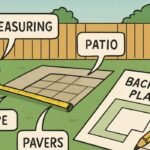Assume: You’re perfectly still in the forest, heart pounding. Just yards away, a majestic stag grazes, utterly unaware of your presence. The secret weapon separating you from detection isn’t magic – it’s the artful drape of Tarnplanen (camouflage tarps) over you and your gear. In a world saturated with visual noise, mastering concealment isn’t just for hunters or soldiers anymore; it’s a skill for wildlife photographers, survivalists, and anyone seeking a deeper connection with the wild. Ready to disappear? Let’s unravel the world of Tarnplanen.
More Than Just a Tarp: Understanding Tarnplanen
Think of Tarnplanen as your personal chameleon cloak. Far more sophisticated than a simple green sheet, these are purpose-engineered concealment covers. They disrupt your human outline, break up predictable shapes, and blend you seamlessly into the surrounding environment using complex patterns and textures. Whether you’re setting up a discreet observation post, hiding hunting equipment, creating a survival shelter, or capturing elusive wildlife on camera, the right Tarnplanen is your invisible ally.
Why Mastering Concealment Matters: The Power of Going Unseen
- Enhanced Success (Hunting & Photography): For hunters, getting closer undetected means ethical, clean shots and higher success rates. Wildlife photographers capture more natural, intimate moments when their subjects remain relaxed and unaware.
- Safety & Security: In tactical or survival scenarios, Tarnplanen provide critical cover, shielding personnel or supplies from visual detection. They are fundamental to fieldcraft.
- Minimizing Disturbance: Blending in reduces your impact on wildlife behavior, allowing for more authentic observation and interaction with nature.
- Versatility: From temporary hides and gear covers to improvised shelters and blinds, Tarnplanen offer multifaceted solutions for diverse outdoor needs.
Decoding the Patterns: Finding Your Perfect Match
Not all camouflage is created equal. Choosing the right Tarnplanen pattern is crucial for effectiveness. It’s not about which one looks “coolest,” but which disappears best in your specific environment.
- Woodland (Waldtarndruck): The classic. Designed for deciduous and mixed forests, featuring browns, greens, and blacks. Ideal for Central European forests.
- Marsh/Swamp (Sumpftarndruck): Incorporates more reeds, lighter browns, and tans. Perfect for wetland edges, reed beds, and marshy terrain.
- Multi-Terrain Patterns (MTP, MultiCam): Modern patterns designed to work reasonably well across various environments (woodland, desert, urban fringes). Offers good adaptability for changing locations.
- Snow/Winter (Schneetarn): Dominated by whites and greys, essential for alpine environments or winter operations.
- 3D Leafy Suit Add-ons: While not the tarp itself, attaching 3D foliage to your Tarnplanen significantly enhances 3D breakup and realism, especially at close range.
Material Matters: Durability Meets Function
The fabric of your Tarnplanen determines its weight, durability, weather resistance, and even its noise level. Here’s a breakdown of common materials:
| Material | Pros | Cons | Best For |
| Polyester | Durable, UV resistant, dries quickly | Can be slightly heavier, less breathable | General purpose, long-term setups |
| Poly-Cotton Blends | Quiet, breathable, natural feel | Heavier when wet, slower drying | Hunting blinds, static hides |
| Ripstop Nylon | Extremely lightweight, packs small, strong | Can be noisy in wind, less UV resistant | Backpacking, mobile hides, photography |
| Mesh Netting | Excellent airflow, lightweight, good breakup | Less weather protection, less concealment | Summer use, ventilation panels, overlays |
Beyond the Basics: Essential Features & Considerations
Selecting Tarnplanen involves more than just pattern and material. Keep these features in mind:
- Reinforcements & Grommets: Look for reinforced corners and edges with heavy-duty grommets for secure tying and staking. This is vital in wind.
- Tie-Downs & Loops: Integrated loops or webbing straps make attaching natural vegetation or securing the tarp much easier.
- Water Resistance & Taped Seams: Essential for staying dry. PU coatings offer good waterproofing; taped seams prevent leaks at stitch lines.
- Fire Retardancy (FR): Critical for military or tactical applications where sparks or flash are a risk. Check certifications.
- Size & Weight: Balance coverage needs with portability. Larger tarps offer more concealment but are bulkier.
- Attachment Systems: Some Tarnplanen feature built-in loops compatible with poles or frames for creating structured hides.
Setting Up Like a Pro: Maximizing Your Tarnplanen Effectiveness
Owning Tarnplanen is step one. Using them effectively is the art:
- Location, Location, Location: Choose your spot wisely. Consider sightlines (yours and the target’s), background, and wind direction (carries scent and sound).
- Break Up Your Outline: Don’t just drape the tarp flat. Create folds, angles, and depth. Use branches, logs, or natural terrain features underneath to add dimension.
- Integrate Natural Vegetation: This is crucial. Weave local grasses, leaves, and small branches into the tarp’s loops or mesh. This instantly localizes the camouflage and adds vital 3D texture. Refresh natural camo regularly as it wilts.
- Mind the Silhouette: Ensure your hide doesn’t create a stark, dark shape against the skyline. Blend the top edges into the background.
- Control Movement & Shine: Minimize any movement behind the tarp. Cover shiny objects (lenses, buckles, watches) inside your hide.
- Consider the Sun: Position yourself so the sun is behind you or to the side, minimizing shadows cast by your hide onto the area you’re observing.
Tarnplanen in Action: Real-World Applications
- The Wildlife Photographer: Sarah K. uses lightweight ripstop Tarnplanen with a ghillie net overlay near a watering hole. By meticulously adding local reeds, she captured unprecedented close-ups of elusive otters, her hide vanishing into the bank.
- The Hunter’s Blind: Markus builds a semi-permanent frame blind on his woodland lease. He covers it with durable poly-cotton Tarnplanen in Woodland pattern, securing it tightly and weaving in fallen branches. The blind becomes part of the forest, allowing deer to pass within yards.
- The Survival Shelter: During a mountain trek, heavy fog rolled in. Alex quickly rigged his Tarnplanen (Multicam pattern) between trees using paracord, creating a windbreak and camouflage from potential aerial search, while signaling his location on one visible side.
- Military Observation Post (OP): A reconnaissance team employs specialized, IR-suppressive Tarnplanen over their dugout, blending seamlessly into the desert scrub terrain, avoiding detection by both visual and night-vision optics.
Maintenance & Longevity: Caring for Your Invisible Asset
Treat your Tarnplanen well, and it will serve you for years:
- Cleaning: Brush off loose dirt. Hand wash gently with mild soap in cold water if heavily soiled. Avoid harsh detergents and bleach. NEVER dry clean.
- Drying: Air dry completely, away from direct sunlight if possible (prolonged UV degrades fabrics). Ensure it’s bone dry before storage.
- Storage: Store loosely folded or rolled in a cool, dry, dark place. Avoid compressing it tightly for long periods.
- Repairs: Patch small tears immediately with fabric repair tape or a sewing kit designed for outdoor gear to prevent fraying.
FAQs:
- Q: Can I wash my Tarnplanen in a washing machine?
- A: It’s generally not recommended, especially for tarps with coatings or delicate netting. Hand washing is safest to preserve waterproofing, colors, and fabric integrity. Check the manufacturer’s label first.
- Q: How durable are Tarnplanen? Will they rip easily?
- A: Durability varies significantly by material. Ripstop nylon is very tear-resistant. Heavy-duty polyester blends are robust. Mesh is more delicate. Look for denier ratings (higher = thicker/stronger thread) and reinforced stress points. Proper use and avoiding sharp snags are key.
- Q: Are there legal restrictions on using camouflage like Tarnplanen?
- A: This is crucial! Laws vary wildly by country and region. In some areas, wearing or using camouflage in public outside of hunting seasons or specific activities (e.g., paintball on designated fields) can be illegal. Always check your local and national regulations regarding the use of camouflage clothing and equipment.
- Q: Can Tarnplanen protect me from the rain?
- A: Many Tarnplanen are water-resistant or waterproof (especially PU-coated polyester). Taped seams enhance this. However, they are primarily designed for concealment, not as dedicated waterproof shelters like a tent fly. Heavy, prolonged rain might eventually seep through, especially under pressure. Use them as part of a shelter system.
- Q: What’s the difference between Tarnplanen and a Ghillie Suit?
- A: Tarnplanen are large sheets/netting used to cover objects, gear, or create hides/blinds. A Ghillie Suit is a wearable garment (like a coat or overalls) covered in strips of material (jute, burlap, synthetic) designed to break up the human silhouette and be adorned with natural vegetation for personal concealment. They are often used together.
- Q: Is adding natural vegetation really that important?
- A: Absolutely! It’s arguably the most important step for effective concealment at close range. No mass-produced pattern perfectly matches every specific location. Local vegetation provides the perfect, dynamic camouflage that moves naturally with the wind, adding essential 3D depth that flat tarps lack.
- Q: Can I use Tarnplanen for my garden shed or as a privacy screen?
- A: While possible, it’s usually overkill and potentially visually jarring in a domestic setting. There are more aesthetically pleasing privacy screens and shed covers available. Tarnplanen are optimized for wilderness concealment.
Read also: Costa Rica’s Fishing Charters: How to Choose the Right One











